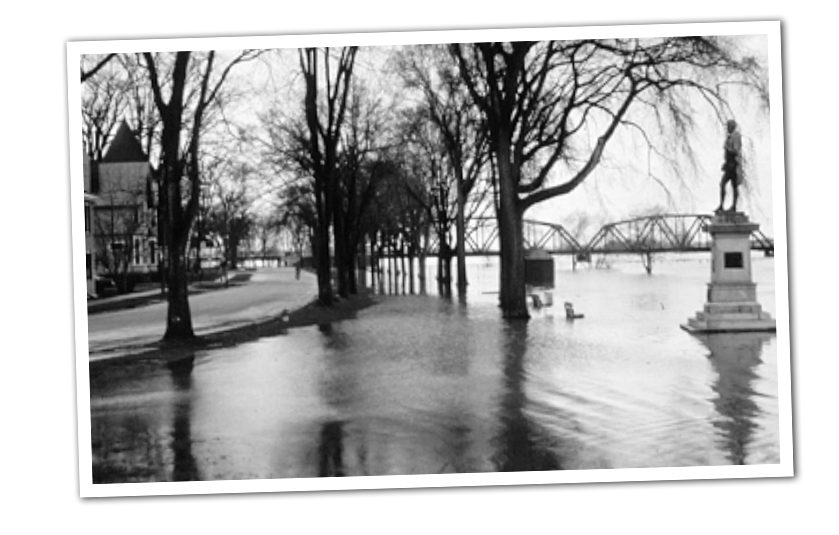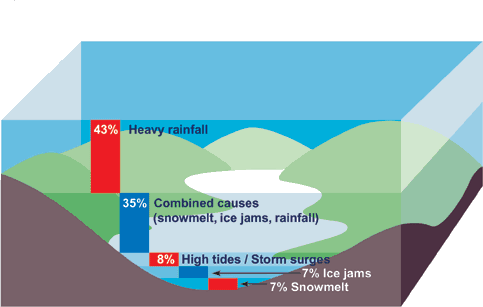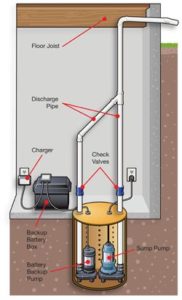
Flood Prevention in New Brunswick
Flood Forecasting Centres Across Canada
- Information on factors affecting flooding such as snow conditions, temperatures, precipitation patterns, water levels and streamflow conditions is routinely monitored by the forecast centre, using a wide variety of telecommunication systems ranging from satellites to the telephone. This information is supplied by several Canadian and U.S.agencies as well as a number of private individuals.
- The information is then input to complex computer models along with up-to-date weather forecasts to produce forecasts of water levels along the Saint John River.
- Flow forecasts are provided year-round, but special attention is paid to the production of forecasts during the high water period in the spring. Flood forecasts are issued to the public through the media and to several U.S. and Canadian agencies such as the New Brunswick Emergency Measures Organization.

Waterloo Row, Fredericton (NB), May 1, 1973
Causes of flooding in New Brunswick

Flooding due to snowmelt may result from spells of warm weather following a winter of heavy snowfall. More often, serious floods involving snowmelt occur when a heavy rainfall accompanies the annual spring runoff, as was the case in the last few years.
As well, this combination often contributes to the formation of ice jams. Although snowmelt was the sole cause of only 7% of the reported floods, it was factor in 40% of the province’s documented flood events. Severe flood conditions associated with ice jamming generally occur in spring breakup, and occasionally in midwinter thaws during January to March.
Property improvements you can make today
- Talk to your agent or insurance broker
Talk to your insurer to find out about what’s covered under your policy. - Talk to your local government
Contact your municipal government to find out about their programs on reducing flooding impacts. - Protect your property
There are many ways to protect your property, from very simple tips to more complex measures. - Get help from a professional
If you’ve experienced major flooding in the past, or have significant structural problems, like cracks in your foundation, you might need help from professionals, like engineers, plumbers or masons. A starting point is working with an independent assessor who can help you to figure out the most affordable solutions.
Ideally, look for an assessor who isn’t associated with any specific contractor, and who isn’t looking to be retained to do the work themselves.
Inside your property
- Use water-resistant building materials for renovations below ground level.
- Put weather protection sealant around basement windows and the base of ground-level doors.
- Install flood shields or barriers for basement windows and doors. The tops of the shields should extend above ground level. Raise large appliances, furnaces, hot water heaters, and electrical panels up on wood or cement blocks above the potential water level. (If an item can’t be raised, consider anchoring it and protecting it with a floodwall or shield.)
- Anchor fuel tanks to the floor. In a flood, a fuel tank can tip over or float, causing fuel to leak and potentially catch fire. Make sure vents and fill-line openings are above flood levels. (If you use propane, contact the propane company before making any changes.)
- If a flood warning is in effect, shut off electricity to areas that are at risk of flooding.
- Move furniture, valuables, and electronics to the safest place in your property that is least likely to be affected by flooding.
Water systems
- Make sure your plumbing system and drains follow Code requirements.
- Install backwater valves or plugs for drains, toilets and other sewer connections.
- Make sure your sump pump is working and install a battery-operated backup, in case of a power failure.
- Install a water alarm to let you know if water is accumulating in your basement.

On your property
- Make sure that your lot is properly graded. If possible, build up the ground around your property so that water can drain away from basement walls.
- Make sure downspouts extend at least 2 m (6’) from your basement wall. Water should drain away from your property and neighbouring properties.
- Check that your roof and eaves are draining properly in heavy rains.
- Check sidewalks, patios, decks and driveways to make sure they haven’t settled over time and are causing water to drain toward your property. Clear snow away from the building’s foundation. If the ground is sloped one inch per foot near the building, moving snow just three to five feet from the building will reduce problems.
- Use a rain barrel to catch water runoff.
- Consider planting a “rain garden” by using landscaping as way to catch and disperse water in the soil near your property. Use native plants and vegetation that will resist soil erosion.
Flood Detectors (Water Alarms)
these little devices can find water the minute it starts, all of them have alarms to warn you that water is present where the device is.
Some have Smart app to notify you by email or by an App in case you are away from your property.
Disclaimers: Vienneau is not affiliated, associated, or endorsed by or in any these product, use at your own risk.
